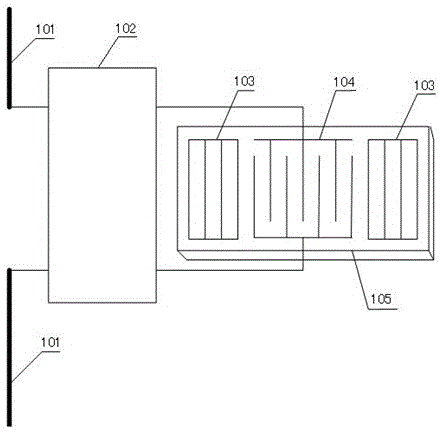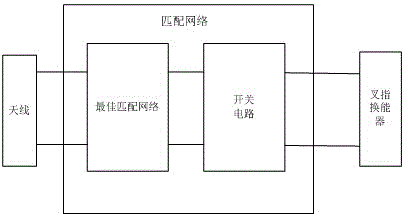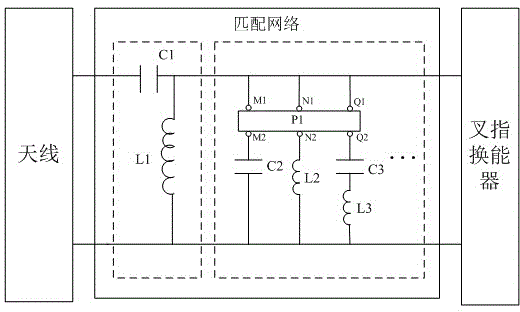Distributed surface acoustic wave resonator and surface acoustic wave sensing system
A surface acoustic wave and distributed technology, which is applied in the direction of instruments, scientific instruments, and record carriers used by machines, can solve the problems of large surface acoustic wave sensors and other problems, and achieve a small footprint, easy implementation, and simple circuit structure. Effect
- Summary
- Abstract
- Description
- Claims
- Application Information
AI Technical Summary
Problems solved by technology
Method used
Image
Examples
Embodiment 1
[0027] Embodiment one, see figure 1 As shown, this embodiment provides a distributed surface acoustic wave resonator, including an antenna 101, a matching network 102, a reflection grid 103, and an interdigital transducer 104, at least the reflection grid 103, and the interdigital transducer 104 Set on the piezoelectric substrate 105, see figure 2 As shown, the matching network 102 includes an optimal matching network composed of at least one capacitor and at least one inductor, and the optimal matching network is also connected in parallel with a switch circuit, and the switch circuit includes several branches connected in parallel, each branch At least one capacitance and / or inductance device is provided, and a switch for controlling the conduction state of the branch is also provided on each branch of the switch circuit. The working principle of the distributed surface acoustic wave resonator in this embodiment is: the antenna 101 receives the excitation signal. In this e...
Embodiment 2
[0028] Embodiment 2, this embodiment provides a preferred circuit of a distributed surface acoustic wave resonator, wherein the switch circuit uses on-site programming to control the switch circuit, see image 3 As shown, the switches of each branch of the switch circuit are controlled by the field programming control logic device P1.
[0029] As a preferred embodiment, the field programming control logic device P1 includes n groups of external contacts. In this embodiment image 3 3 sets of external contact points are given in , namely (M1, M2), (N1, N2), (Q1, Q2), and these 3 sets of contacts are respectively connected to the 3 branches of the switch circuit, namely , each branch of the switch circuit has a group of external contacts in series, and the on-site programming control logic device P1 controls the conduction state of each group of external contact points through programming. For example, when the on-site programming control logic device P1 controls (M1, M2 ) is t...
Embodiment 3
[0034] Embodiment 3. This embodiment illustrates the basic principle of the distributed surface acoustic wave resonator in Embodiment 2. Since capacitors and / or inductors are connected in series in each branch, no matter whether any branch is newly connected to the matching network, Both will change the reactance value of the matching network. This embodiment gives another way of incorporation, see Figure 4 As shown, the equivalent capacitive reactance of the matching network is C′, the equivalent inductive reactance L′, and the calculation method of the impedance value Zeq2 of the matching network is:
[0035] (1)
[0036] (2)
[0037] The general near-resonator equivalent circuit model of a resonator is as Figure 5 as shown, Figure 5 C and L are the dynamic capacitance and inductance caused by the elasticity and inertia of the piezoelectric substrate, respectively, R is the dynamic resistance caused by damping, C0 is the static capacitance of the IDT, and R0 is th...
PUM
 Login to View More
Login to View More Abstract
Description
Claims
Application Information
 Login to View More
Login to View More - R&D
- Intellectual Property
- Life Sciences
- Materials
- Tech Scout
- Unparalleled Data Quality
- Higher Quality Content
- 60% Fewer Hallucinations
Browse by: Latest US Patents, China's latest patents, Technical Efficacy Thesaurus, Application Domain, Technology Topic, Popular Technical Reports.
© 2025 PatSnap. All rights reserved.Legal|Privacy policy|Modern Slavery Act Transparency Statement|Sitemap|About US| Contact US: help@patsnap.com



